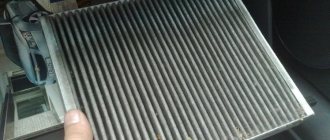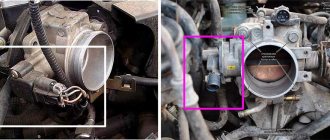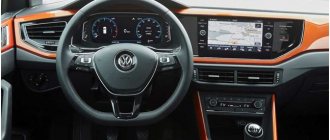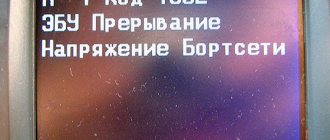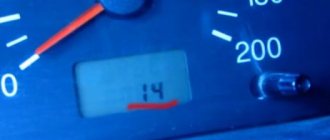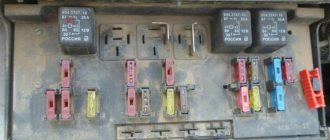Modern cars are equipped with electronic control modules that diagnose the engine, chassis components, transmission and safety systems. The Chevrolet Cruze is equipped with a unified electronic engine control system (ECM).
Information about the state of the mechanisms comes from various sensors to control units (ECU), where the analysis, adjustment and optimization of the operation of all units occurs.
The ECU allows you to carry out computer diagnostics of the car, detect failures and breakdowns at an early stage, preventing emergency situations.
Types of electronic control units and their purpose
An electronic control unit (controller unit) is a microprocessor with software capable of analyzing data on the operation of subsystems, displaying error codes on the dashboard, on-board computer and transmitting control commands to the electronic-mechanical actuator where the failure occurred.
The ECU receives information about the quality of the fuel mixture (oxygen sensor), the position of the throttle valve and gas pedal, various temperature and level indicators (oil, coolant, engine temperature), the operation of the crankshaft and timing belt, pressure in hydraulic units and tires, and much more. to control all systems.
In total, a basic car can be equipped with 10 or more sensors and several controller units, which are divided into types:
The blocks are integrated into a common control system and operate in constantly changing modes, ensuring the joint correct operation of all mechanisms.
Each malfunction is systematized and defined by its own code, which is displayed on the on-board computer in the form of a “check” of a general indicator or a specific error code during computer diagnostics.
Diagnostics involves connecting the ECU via an OBD 2 scanner adapter to a laptop (computer or smartphone) with the necessary software installed.
Structure of Chevrolet Cruze error codes
Each error code consists of five characters: one letter and four numbers. Decoding the code shows the final malfunction of a component or unit in the car.
The letter in the code indicates the system in which the failure occurred:
The second digit indicates the manufacturer's factory code or OBD 2 system code.
The third digit indicates the type of fault:
The last two digits indicate the specific faulty component, mechanism or sensor. For example: computer diagnostics revealed errors code P0300, P0351 or P0171.
Deciphering these codes shows a specific problem: misfire. The engine controller receives information from the crankshaft and camshaft position sensors, calculating the rotation speed and misfire of the fuel mixture in each cylinder when the engine is running.
In the first code (P0300), the cause may be a faulty catalyst, in the second (P0351) - disturbances in the ignition control circuit, the third (P0171) indicates a lean mixture, which indicates a malfunction in the fuel system (drop in fuel or air supply pressure, malfunction injectors, poor quality fuel).
If error P0172 is issued, the problems will be the same with a positive sign - the mixture is too rich in oxygen.
Technical description and interpretation of error P0136
This diagnostic trouble code (DTC) is a generic powertrain code. The P0136 code is considered a common code because it applies to all makes and models of vehicles. Although the specific repair steps may vary slightly depending on the model.
DTC P0136 refers to the second oxygen (O₂) sensor located on Bank 1, after the catalytic converter. It measures the amount of oxygen entering the exhaust gases.
There are four wires to the O₂ sensor. Two wires are for the heating element and two wires are for sensor data. The heating element should have battery voltage on one wire when the engine is off. And grounding on the other.
The PCM supplies a voltage of 0.5 volts to the O₂ sensor, which it varies depending on the oxygen content of the exhaust gases. The PCM also provides grounding for the sensor.
Changes in oxygen content cause changes in the resistance of the O₂ sensor. This change in resistance affects the 0.5 volt voltage supplied by the PCM. It can vary from 0.1 to 0.9 volts. A value of 0.1 indicates complete leanness and 0.9 indicates complete enrichment.
The meaning of this code is that the O₂ (oxygen sensor) voltage has been low for more than 2 minutes, or the sensor is not active at all. This is perceived by the Engine Control Module (ECM) as a malfunction and therefore sets the P0136 OBD2 error code.
Diagnostic instructions and procedures
If a malfunction is detected in the engine, the ECU sends a signal to the car’s dashboard, where the “check engine” indicator lights up. System errors are recorded in the memory log in the form of codes.
If the error is not critical, then to correct it it is enough to reboot the controller unit or reset the ECU settings.
If a sensor, component or unit breaks down, the indicator will remain on until the problem is resolved.
In pre-restyling versions of the 2011 Chevrolet Cruze, to reset ECU errors, you must perform several step-by-step steps:
The indicator light should stop lighting - the ECU errors have been reset.
For computer diagnostics, error codes are read through the ODB 2 connector and the cause of the failure is determined. If the car does not start and the error code is P0016, then its interpretation means the crankshaft and camshaft are incorrectly positioned relative to each other.
The sensors determine which cylinder is misfiring, the ECM sends a signal to stop the fuel supply, and the engine does not start. Diagnostic information is analyzed, and troubleshooting actions begin with testing the electrical circuit. Possible minor irregularities may be the source of the problem: faulty or removed contact terminals, loose connections, worn wiring or damaged insulation.
If no damage is found in the electrical circuit, then check according to the diagnostic table. For example: when the camshaft position sensor is disconnected, the scanner should count error P0340, and when the power is turned off (removing the terminal from the battery), the scanner counter stops.
This operation allows you to determine the reason for the engine failure to start: the error values are increasing - there are serious problems with the motor or the ECM is not working correctly. A complete list of ECU error codes can be found in the technical description of the Chevrolet Cruze.
During complex diagnostics, all vehicle systems are scanned - the information obtained allows you to determine the general condition of all components and assemblies, the sensors themselves and the controller units.
Any technical malfunction is recorded as an error code, remaining in the memory log. Thus, you can estimate the cost of the machine by tracking all the malfunctions and failures over the past period of operation, as well as identify possible future problems.
Reasons that can cause a fire "Check engine"
One of the most harmless reasons for the appearance of a check on a Chevrolet Cruze is the use of low-grade fuel. Usually this problem manifests itself a few kilometers after visiting a gas station.
Refueling with low-octane gasoline leads to detonations when the air-fuel mixture ignites. The electronic control unit records this violation in engine operation and issues a command to the “Check engine” indication.
A low engine oil level or insufficient circulation as a result of a clogged filter leads to poor lubrication of friction units. This causes increased loads and excessive wear on motor components. If a malfunction is detected in the oil circuit, the ECU lights a check.
While stuck in a traffic jam, the power plant may overheat. The lack of cooling of the radiator by counter air flows leads to a rise in temperature above the optimal one.
To maintain stable operation of the power unit, the Chevrolet Cruze has a lot of sensors. Failure of any of them leads to incomplete information to the ECU, which makes it impossible to control the engine normally. The revs begin to fluctuate, the dynamics deteriorate, and fuel consumption increases. Very often the engine starts to stall. At the same time, the driver may notice the “check engine” light on the instrument panel.
If ESP OFF, slippery road and “Check engine” light is on, then a common cause is a dead battery. After charging it, it is usually not difficult to remove the illuminated indicators.
Chevrolet Cruze errors: error codes, self-diagnosis
A tire pressure gauge is used to measure tire pressure. The standard pressure for a Chevrolet Cruze, regardless of engine type and tires, is 220 kPa (2.2 bar).
A spark plug wrench is used to remove the spark plugs. The frequency of changing spark plugs depends on the type of engine. The manufacturer recommends the following intervals:
| LXT | After 30,000 km |
| LUJ, LUV, LDE, 2H0 | After 60,000 km |
Chevrolet Cruze spark plug change frequency
To check the quality of brake fluid, a special device is used - a “tester”, which has status indicators.
Computer diagnostics allows you to obtain the most detailed information about the condition of the car. It is performed using a device (scanner) connected to the diagnostic connector of the car and the USB port of the computer. The Chevrolet Cruze is equipped with an OBD-II on-board diagnostic interface with a CAN bus. The scanner reads information from sensors and displays the data in a computer program. In the program itself, you can get complete information about the car (find out the serial number, equipment, etc.), adjust parameters and reset on-board computer errors (Checks). Computer diagnostics has the utmost accuracy in identifying faults and can be performed not only at a service station, but also with your own hands.
The cost of comprehensive diagnostics for a Chevrolet Cruze averages 7,500 rubles. Prices for subsequent repairs (for example, automatic transmission repairs) between models with an engine capacity of 1.6 and 1.8 may differ significantly.
Replacing front and rear pads of Chevrolet Cruze
Disc brakes are a design feature of the Chevrolet Cruze. The activity of changing pads is not too difficult to do independently. Therefore, there is no need to spend money on an expensive service station. Follow the algorithm of actions and achieve your goals
When to change Chevrolet Cruze pads
An indicator of the need to change Chevrolet Cruze brake pads is the size of their thickening. The composition applied to them must be at least 2 millimeters. If the wear of the pads is uneven, then you need to check the caliper. There are clearly problems with it. The engineers provided for the presence of a special plate. If abrasion has reached critical levels, then the pads will whistle while moving. This factor encourages urgent action.
Do not neglect obvious signs. Do not endanger yourself and those around you. It’s good if you only have to reimburse the financial component. Problems arising as a result of inaction: leakage of brake fluid and non-working brake, lengthening of the braking distance, wheel locking and skidding of the car.
Set of tools for repair:
Algorithm for changing rear brake pads of Chevrolet Cruze
We change the brake pads on the rear of the car. Work progress:
You can get to the rear pads by dividing the caliper into parts. There will be two of them. Using the “No. 13” wrench, unscrew the fastening joints. At the same time, hold the guides with the “No.18” key. Do not allow it to rotate - this will lead to boot defects.
After completely removing the fasteners, remove the part of the caliper from above. Remove used pads. Use a screwdriver if necessary. Remove the plate fixing spacers. Over time, they weaken and do not hold the pads securely.
The Chevrolet Cruze has an interesting brake cylinder. Pressing it in is quite problematic. Use an additional tool to accomplish your plan (pliers or wrench). Rotate it to the right with noticeable force. Its surface should be flush with the boot. Otherwise, it is impossible to connect the caliper again. The new pads are much thicker than the old ones.
The upper part of the block is equipped with a specialized protrusion in the center. When carrying out installation work, make sure that this mark coincides with the hole in the brake cylinder. Carry out a thorough cleaning of the location of the elements of the new plates. Install new fasteners. Often they are included in the package of linings.
Carrying out lubrication work with ceramic grease is not a prerequisite, but is recommended by experienced car enthusiasts and specialists. It is necessary to prevent brake pads from sticking and eliminate unnecessary noise.
Lubricate the surfaces of the brake cylinders and the locations of the brake pads themselves. You can apply lubricant to the caliper guides. Don't expect a lightning-fast effect. The paste will be able to settle and partially harden only after some time. It is heat-resistant and does not lose its quality at all. But the noise from the pads will stop completely. Other types of seals will no longer be needed.
After installing the pads, secure the upper part of the caliper with mounting screws. You have completed a complete change of brake pads. The process itself is easy to implement and practically does not require specialized knowledge and skills.
Replacing Chevrolet Cruze front brake pads
Changing the pads on the front is much easier. It is enough to unscrew one fixing screw. It is located at the bottom of the caliper. Apply key "No13". Turning the wheel outward until it stops will greatly facilitate access to the repair site.
You can press in the brake cylinder in advance. Before removing the used pads. Point the screwdriver inward (use the support lever method) and push the cylinder in. Didn't work out right away? Open the caliper and take the larger lever.
Opening the upper part of the caliper freed up passage to the pads. Use the already known algorithm for changing pads. Pull out the used linings and fixing elements. Use a metal brush to clean surfaces before future installation.
Install new fixing plates and brake linings after applying ceramic lubricant (also optional). To reliably treat all surfaces with lubricant, unscrew the second mounting screw.
Close the caliper and tighten the mounting screws. Remember to maintain the guide.
Advice from the experts
Disc brakes are reliable and easy to maintain. Listen to the advice of the master and feel free to carry out repairs yourself.
Carefully study the algorithm for performing repair work. It is useful to watch video material on the topic. Having carefully prepared, you can begin to do the work yourself. Carefully, slowly, diligently carry out all the points of the proposed work algorithms. Pay special attention to the suggestion of treating surfaces with ceramic lubricant. With minimal material and labor costs, you can achieve the desired result.
Chevrolet Cruze codes (errors, VIN, paint)
Most modern cars, including the Chevrolet Cruze, have a lot of different specifications, numbers and codes. Each spare part and each part has its own catalog number. On the instrument panel, the on-board computer displays Chevrolet Cruze fault codes so that the owner or service technician immediately understands what the problem is. For authorities and services, each car is equipped with its own VIN code, which provides comprehensive information about the car. Well, if painting is required, there is no need to select or guess the required color - each paint for Chevrolet Cruze has its own code, knowing which you will get rid of problems when painting or restoring the paintwork.
Diagnostic instructions and procedures
If a malfunction is detected in the engine, the ECU sends a signal to the car’s dashboard, where the “check engine” indicator lights up. System errors are recorded in the memory log in the form of codes.
If the error is not critical, then to correct it it is enough to reboot the controller unit or reset the ECU settings.
If a sensor, component or unit breaks down, the indicator will remain on until the problem is resolved.
In pre-restyling versions of the 2011 Chevrolet Cruze, to reset ECU errors, you must perform several step-by-step actions:
The indicator light should stop lighting - the ECU errors have been reset.
For computer diagnostics, error codes are read through the ODB 2 connector and the cause of the failure is determined. If the car does not start and the error code is P0016, then its interpretation means the crankshaft and camshaft are incorrectly positioned relative to each other.
The sensors determine which cylinder is misfiring, the ECM sends a signal to stop the fuel supply, and the engine does not start. Diagnostic information is analyzed, and troubleshooting actions begin with testing the electrical circuit. Possible minor irregularities may be the source of the problem: faulty or removed contact terminals, loose connections, worn wiring or damaged insulation.
If no damage is found in the electrical circuit, then check according to the diagnostic table. For example: when the camshaft position sensor is disconnected, the scanner should count error P0340, and when the power is turned off (removing the terminal from the battery), the scanner counter stops.
This operation allows you to determine the reason for the engine failure to start: the error values are increasing - there are serious problems with the motor or the ECM is not working correctly. A complete list of ECU error codes can be found in the Chevrolet Cruze data sheet.
During complex diagnostics, all vehicle systems are scanned - the information obtained allows you to determine the general condition of all components and assemblies, the sensors themselves and the controller units.
Any technical malfunction is recorded as an error code, remaining in the memory log. Thus, you can estimate the cost of the machine by tracking all the malfunctions and failures over the past period of operation, as well as identify possible future problems.
Chip tuning and firmware for Chevrolet Cruze:
Serial firmware is designed to ensure a balance between consumption, toxicity standards and dynamic characteristics of the engine.
The main goal of tuning firmware is to boost the engine, to squeeze out the maximum possible performance. This is achieved by filling the ECU firmware with an arc, which was edited manually.
Common mistakes
First, let's look at decoding frequently occurring problems that occur in the Chevrolet Aveo in the T250, T300, Niva and other models.
Let's consider the malfunctions encountered in the operation of power units.
How to do it yourself?
There are two ways to check for errors in Chevrolet: self-diagnosis or using additional equipment or a computer. In order for the on-board computer to test for faults, you need to hold down the button on the odometer to reset the daily mileage and turn the key in the ignition. This will cause the needles on the speedometer and gauges to start moving along the scales. And when you press the button again, the ECU will display a message on the display about the version of the firmware being used. After the next press, combinations of problems, if any, will appear on the screen.
What codes may appear on a Chevrolet Niva after self-diagnosis:
READ Replacing the expansion tank Opel Astra j
Screenshot of a computer utility for testing Niva Chevrolet
If the car’s control module has detected several problems, a number will appear on the display corresponding to all the breakdowns at once. For example, error 10 is the sum of codes 2 and 8, etc.
In the latest versions of Chevrolet, the following messages may appear on the instrument panel:
For detailed testing, you can use an adapter with a laptop:
ECU location:
The control unit is located in the engine compartment, next to the battery. The communication blocks are located on top.
Methods for diagnosing ECUs and errors on a Chevrolet Cruze via OBD2
Let's look at examples of options for analyzing Chevrolet electronic systems.
Cruz Chevrolet code 95 how to remove
Good afternoon, I can’t clear the error - code 95, it says that there is a mechanical error - open circuit - short circuit - no grounding.
As I understand it, the whole problem is in these yellow clips in the photo and the contact has come off due to the fact that its passengers constantly touch their feet under the seat?
Scanner: Delphi DS150E
- squawk
- March 09, 2016
- 20:33
Your pop warmer is not working??
- norfolk197609
- March 09, 2016
- 20:41
Well, remove the terminal and check the contact under your seat.
If everything is ok there, then it means that the snail on the steering wheel may have broken and the SRS unit does not see the airbag
- sell199505
- March 09, 2016
- 22:16
norfolk197609, I looked in, there’s some kind of homemade thing there, there’s a resistor screwed in manually, on the passenger side it’s not there at all and the wire is stupidly hanging out - tomorrow I’ll go to the electricians, let them look at what kind of heresy there is.
- norfolk197609
- March 09, 2016
- 22:17
sell199505, used car? So the pillows are shot
- sell199505
- March 09, 2016
- 22:20
norfolk197609, the car is used - but according to the scanner the airbags are all active and in working position and there are no traces of their activation and the car was completely checked for painting, etc. - probably the craftsmen themselves tried to remove the error
- sell199505
- March 09, 2016
- 22:23
norfolk197609, everywhere it produces 3-4 ohms and on the driver's side all 53 ohms
- norfolk197609
- March 09, 2016
- 22:25
sell199505, after the airbags fire, the craftsmen solder a transistor with a resistance into the circuit so that the system thinks that all the airbags are active. So when you scan you see that they are there. Remove the steering wheel cushion and see if there is a plug there
- sell199505
- March 09, 2016
- 22:30
norfolk197609, I looked at the steering wheel recently, they took everything apart - everything is in place, it’s just a mess with wires under the seat, either the passengers mutilated them with socks or whatever - the car is not broken at all. Yes, I looked on the forums - many people have this error, and on almost new cars with mileage starting from 4k
- sell199505
- March 09, 2016
- 22:31
norfolk197609, tomorrow I’ll go to the electricians and write what happened.
- norfolk197609
- March 09, 2016
- 22:31
sell199505, photo to the studio)
- sell199505
- March 09, 2016
- 22:32
norfolk197609, the car is already locked and in the parking lot
- sell199505
- March 09, 2016
- 22:33
norfolk197609, will this one work?))) I took a photo back in the summer
- norfolk197609
- March 09, 2016
- 22:34
Nope, I meant by sidukha)
- sell199505
- March 09, 2016
- 22:35
norfolk197609, and I thought about the airbags on the steering wheel - I'll take them off tomorrow morning)
Watch an interesting video on this topic
Source: https://eurasia-avto.ru/kruz-shevrole-kod-95-kak-ubrat.html
Frequently asked questions about auto diagnostics via a computer or smartphone
Let's look at the most common questions that owners have when diagnosing a Chevrolet.
Diagnostics of Chevrolet Cruze sensors via OBDII
You can read sensor readings through various service software and even through a simple ELM327 scanner. Popular options: Torque PRO, Scanmatik, OBD Car Doctor. Diagnostics is possible for the following components:
Other systems available for diagnostics: phase sensor, crankshaft position, detonation, oil and fuel pressure.
On which cars is this problem most common?
The problem with code P2723 can occur on different machines, but there are always statistics on which brands this error occurs more often. Here is a list of some of them:
- Audi
- Buick
- Cadillac (Cadillac Escalade)
- Chevrolet (Chevrolet Captiva, Cruz, Silverado, Equinox, Epica)
- Dodge
- GMC
- Honda
- Land Rover
- Mercedes
- Nissan
- Opel (Opel Astra)
- Pontiac
- Saturn
- Skoda
- Volkswagen (Volkswagen Polo Sedan)
With fault code P2723, you can sometimes encounter other errors. The most common are the following: P2722, P2724, P2725, P2726.
Advice from an auto expert on how to decipher the error code on a Chevrolet Cruze
Code 15 - The additional brake light, which is installed either on the rear spoiler or rear window, has failed and needs repair. Code 16 - Check the integrity of the main brake lights. Code 17 - Chevrolet Cruze, how to check for faulty electric or hydraulic headlight adjustment errors.
Code 18 - You have a problem with the low beam of the front optics. Code 19 - The rear fog lights need to be checked and possibly repaired.
Code 20 - Check the right light bulb to see if the low beam is on, there may be a problem. Code 21 - Check the left headlight to see if the side light is on. Code 22 - Check the right headlight to see if the side light is on. Code 23 - Malfunction of the reverse light. Code 24 - Not Chevrolet Cruze how to see rear license plate illumination errors. Code 25 - The front left turn signal does not light up.
Code 26 - The rear left turn signal does not light up. Code 27 - The front right turn signal does not light up.
Diagnostics
So, an icon with or without an inscription appeared on the instrument panel. What to do - go to a car service? No, you can just look in the service book, where the symbols are written. Here's a breakdown of the icons:
The time to change the engine oil is approaching (less than 5% service life)
Fill the oil and reset the readings of this resource
If the message does not disappear after filling the oil, then let the power unit operate in the thermodynamic cycle, since the instrument cluster is normal
Low engine oil pressure - stop the engine
Performed after replacing devices or when information appears on the display. the center of such a message. We recommend carrying it out using the SPS system
The error is displayed when a problem is detected by the ECM engine control unit
Scanners are used to carry out diagnostics. There are laptops and computers. So, the latter includes a laptop or tablet, from which all operations can be carried out if you have the appropriate software.
Portable or display ones are very expensive, but their operating principle is the same - to identify errors and malfunctions in the electronic engine control unit.
Diagnosis of car faults using a scanner.
After connecting through a special connector, a test scan is carried out, which shows the presence of errors. Based on the errors, you can determine in which node the fault is hidden.
Decoding error code 89 in a Chevrolet Cruze
Code 28 - The rear right turn signal does not light up. Problems with the throttle valve. Chevrolet Cruze vehicles are equipped with electronic throttle. The most common problems with Chevrolet Cruze how to view errors are the following: Since the ECU controls the position of the throttle valve, it indicates to the driver with error 84 that it does not close completely.
READ How to refill the air conditioner in a Chevrolet Lacetti
In such a situation, you will need to clean the throttle valve; Erase a contact. Under the throttle cover there are contacts and tracks - 4 pieces each. A common problem is the center contact rubbing off. Deciphering the Chevrolet Cruze VIN code is a fairly simple procedure if you know what its designations mean.
ABS error and error code 89 on Chevrolet Cruze.
Code 7 - You need to turn the car's steering wheel, then turn off the ignition and turn it on again. At this point the code is stamped on the metal, so it cannot be torn off or changed.
How to decipher the VIN code? Deciphering the Chevrolet Cruze VIN code is a fairly simple procedure if you know what its designations mean.
Therefore, let's take a closer look at the structure of which it consists. The code consists of seventeen numbers and letters of the Latin alphabet. These signs are combined into three groups, each of which carries its own information: P This error is common for Lacetti and Cruze cars with an automatic transmission.
In particular, this combination indicates incorrect operation of the power unit controller. P The control unit has detected a mechanical malfunction of the charge drive at idle speed. R The ignition switch-off timer in the engine control system has failed. Combination Explanation P As stated above, how to view the error code on a Chevrolet Cruze P is a common combination when diagnosing Chevrolet cars.
System errors are recorded in the memory log in the form of codes. If the error is not critical, then to correct it it is enough to reboot the controller unit or reset the ECU settings. If a sensor, component or unit breaks down, the indicator will remain on until the problem is resolved.
As you can see, there are two types of Chevrolet Cruze diagnostics and errors. So, one option is scanning through the instrument panel, and the second through a scanner. Both methods are good, but with the help of diagnostic equipment you can more accurately determine exactly where the problem lies.
see also
Comments 101
Tell me, which program is best to use to watch Cruise via elm usb?
What about the one on the screenshots that you’re not happy with?
I haven’t tried it yet, it seems to come with the scanner
What about the one on the screenshots that you’re not happy with?
Hello, are there any goodies that I can enable? for example, so that a key fob that has been wound up with a standard key can be closed with a button, otherwise in winter you have to turn the cylinder with a second key, and in general, some kind of adjustments and settings
Hello. No, just read the errors and watch the operation of the sensors responsible for the operation of the engine.
Hi all! Chevrolet Cruze 2012 The open door problem started. Everything is closed, but the alarm also shows when the standard alarm is turned on that the door is open. Is it possible, using the existing ELM327, to determine which door or trunk is fooling you?
It's unlikely to show. Most likely the limit switch is faulty on some door.
The elm cord doesn’t sew anything here, it’s only magicians who are lucky with the functions))
Well, I know Ford Sew Elm. How can I flash it with what adapters?
Ask in the community.
I also use this program. a good thing)
the adapter on the ELM327 does not see all errors, with its help we can only see what is transmitted via OBDII, and there is also a protocol that Chevrolet (GM) uses, and without a dealer scanner, according to my MDI, we will not be able to see anything (
This is true. I only need it for engine diagnostics, to see what sensors work, what errors are in the engine ECU. The rest doesn't interest me. Yes, and software for dealer scanners costs a lot of money, and, if memory serves, you can’t just buy it.
Chip tuning
Some drivers do chip tuning of the Chevrolet Niva in order to increase engine power. The essence of this procedure is to remove the established restrictions by adjusting the optimal factory settings in the electronic control unit. This procedure helps to extract the additional performance inherent in the motor.
The whole process can be divided into several stages:
The main advantage of this procedure is:
The disadvantages include:
Each specialist has a different attitude towards chip tuning, some consider it useful, while others think that this procedure can negatively affect the performance of the car, while reducing its service life.
Chevrolet Cruze diagnostics and errors
In pre-restyling versions of the Chevrolet Cruze, to reset ECU errors, you need to perform several step-by-step actions: The engine warms up to operating temperatures at elevated speeds. After the specified time, the battery is connected again, the key is inserted into the ignition switch, turning on the electrics, the dashboard indication should be on.
After one minute, the engine is restarted and left to idle for minutes without touching the gas pedal. The launch must be repeated how to view the error code on the Chevrolet Cruze once.
The indicator light should stop lighting - the ECU errors have been reset. Who wants to lose extra money?
Diagnostics from an official dealer costs about rubles, and this is only the test itself, without solving the problem. But in practice, code 89 tends to appear and disappear on the screen.
Therefore, if you decide to be serviced by a dealer, then you need to go to him when the code is always on, without disappearing.
Ecotec series engine for Chevrolet Cruze
It is worth listening to the engine. Many copies suffer from extraneous noise, the culprit of which is the timing belt tensioner pulley, which tightens the belt too much. Moreover, the Lacetti had no such problems on the same engine. Cruise's tension roller has been modified and the spring stiffness has been increased. That’s why many owners either install a Lacetti roller or manually weaken the spring. A clogged EGR system valve also causes trouble, which inevitably leads to increased fuel consumption. If you are not very concerned about the environment, instead of repairing the system, you can programmatically turn it off. Also check if the lambda probe has been changed. It can safely be classified as a consumable, since there are frequent cases of breakdowns even during the warranty period.
There are many cars with Ecotec series engines with a displacement of 1.6 and 1.8 liters (indexes F16D4 and F18D4, respectively), which are also found on many Opels. Cars of the first years of production often have problems with the CVCP variable valve timing system, which is very sensitive to the condition of the lubrication system and the level of engine oil. Due to oil starvation, gear failures due to shock loads are common. At the end of 2009, the problem was eliminated by installing reinforced elements of the system. And in 2011, a slightly modified version of the F16D4 with a power of 124 hp appeared. With. (the increase was 10 hp).
We also have cars with a 1.4 liter supercharged engine, familiar from the Opel Astra J. But there are few such examples on the market. As well as diesel modifications.
Transmission
The Chevrolet Cruze used a 5-speed manual or 6-speed automatic transmission as a transmission. A manual transmission is characterized by twitching that appears after 70–80 thousand kilometers when switching from first to second gear. This is due to the failure of the clutch disc due to a violation of the geometry of the damper springs, which is associated with a factory miscalculation. Many owners, when symptoms appeared, replaced the original clutch with non-original analogues, and the problem disappeared. Mechanics are also prone to transmission oil leakage. Seals can leak after 20–25 thousand kilometers. Therefore, be sure to inspect the copy you like for smudges.
As an automatic transmission on the Cruise, a proven Jimmy 6-speed hydromechanical 6T30 was used. Among six-speed gearboxes, this is perhaps one of the most reliable transmissions. Nevertheless, it does have weaknesses. Be sure to go to higher gears during your test drive. After 150–160 thousand kilometers, some cars may experience dips when shifting between fourth, fifth and sixth gears. Sometimes the highest levels can be completely “lost.” This is due to worn channels in the valve body. An expensive unit can be repaired, but even in this case the costs will be enormous. Therefore, for prevention, it is worth changing the oil more often, and in this case the transmission will last quite a long time.
Chassis
Chevrolet Cruze is built on the global Delta II platform, which it shares with the Opel Astra J and Chevrolet Aveo. Therefore, it is related to them not only by the units, but also by the chassis with its problems. Most cars (if not all) suffer from squealing noise from their front brake calipers. It is caused by play in the guide fingers. Replacement, if it helps, will not last long. The most effective way to combat this is to apply thick grease to the guides. Although this will only be a temporary solution. Another weak link in the braking system is the rapid wear of the front brake discs, which are made of low-quality metal. They may require replacement at 30 thousand kilometers.
ALDL connector type - 12-pin rectangular diagnostic connector
| A | WEIGHT |
| B | Diagnostic terminal (connect pin B to pin A with a jumper, turn on the ignition, the “MIL” lamp will emit a series of flashes: a long flash (tens) short flashes (units) between the error code there is a long pause. Code 12 will be shown first (flash, short pause and two fast flashes), this means the start of diagnostics, and then error codes. Each error is shown 3 times in a row, and then the next error comes, and so on in a circle while the jumper is in place. |
| C | |
| D | |
| E | |
| F | |
| G | Fuel pump |
| M | K-line diagnostics |
| H | +12V (not available on some models) |
Self-diagnosis codes Chevrolet 1992-1994
OBD-II connector type - 16-pin OBD-II Chevrolet trapezoid connector
| 1 | none |
| 2 | none |
| 3 | none |
| 4 | Body grounding |
| 5 | Signal Ground |
| 6 | Line CAN-High, J-2284 |
| 7 | K-line diagnostics (ISO 9141-2 and ISO/DIS 14230-4) |
| 8 | none |
| 9 | SCS (Service Check System) - Output for reading slow self-diagnosis codes |
| 10 | none |
| 11 | none |
| 12 | none |
| 13 | none |
| 14 | Line CAN-Low, J-2284 |
| 15 | L-line diagnostics (ISO 9141-2 and ISO/DIS 14230-4) |
| 16 | Power supply +12V from battery |
Chevrolet diagnostic connector location
Chevrolet Cruze Chevrolet Lacetti Chevrolet Camaro
Chevrolet Corvette Chevrolet Malibu
How to do a self-diagnosis on a Chevrolet Cruze
When strange numbers or symbols appear on the Chevrolet Cruze instrument panel, this means an error due to a car malfunction, which is important to be able to decipher, reset and correct the condition of your vehicle. With each new version of the Chevrolet Cruze, it becomes more and more difficult to read codes, as their number increases significantly. But let's look at how to behave in a situation where an error appears on the panel, how to clear the code yourself, when computer diagnostics of a car at a service station cannot be avoided, what PC programs will help you with self-diagnosis and a complete list of codes for the 2014 Chevrolet Cruze.
Symptoms of malfunction
The main driver symptom of P2723 is the MIL (Malfunction Indicator Light) illumination. It is also called Check engine or simply “check light”.
They can also appear as:
- The “Check engine” warning light on the control panel will light up (the code will be stored in the ECM memory as a malfunction).
- The car goes into emergency mode.
- The gearbox slips when changing gears.
- The transmission is stuck in gear.
- Hard gear shifting.
- Transmission overheating.
- Increased fuel consumption.
- Symptoms similar to misfires may occur.
The severity of the P2723 code is usually moderate, but can quickly progress to a more severe level if not corrected promptly.
What to do when the main error messages come on
| Meaning | Translation | What to do |
| Change Engine Oil Soon | The time to change the engine oil is approaching (less than 5% service life) | Fill the oil and reset the readings of this resource |
| Low Engine Oil Level | Low engine oil level | If the message does not disappear after filling the oil, then let the power unit operate in the thermodynamic cycle, since the instrument cluster is normal |
| Oil Pressure Low – Stop Engine | Low engine oil pressure - stop the engine | Bringing the indicator into line |
| Program Cluster | Program the instrument cluster | Performed after replacing devices or when information appears on the display. the center of such a message. We recommend carrying it out using the SPS system |
| Service Vehicle Soon | The next vehicle maintenance is approaching | The error is displayed when a problem is detected by the ECM engine control unit |
| Vehicle Overspeed | Speeding car | Reduce speed |
Troubleshooting Check Engine
In order to reset the check engine, Chevrolet Cruze car owners recommend removing the negative terminal from the battery for 10 minutes. If a false error occurs, the ECU independently eliminates the “Check engine” icon according to one of three established algorithms:
Fault with low risk of false alarm:
Malfunction with an average risk of false lightning of the check
High risk problem “Check engine”
If the “Check Engine” icon lights up or blinks again after a reset, then you need to find the reasons for its appearance. Otherwise, the extinction of the check will only be temporary. In addition, the components of the power unit will be subject to increased wear. Failure to report problems may result in costly major repairs.
Structure of Chevrolet Cruze error codes
Each error code consists of five characters: one letter and four numbers. Decoding the code shows the final malfunction of a component or unit in the car.
The letter in the code indicates the system in which the failure occurred:
The second digit indicates the manufacturer's factory code or OBD 2 system code.
The third digit indicates the type of fault:
The last two digits indicate the specific faulty component, mechanism or sensor. For example: computer diagnostics revealed errors code P0300, P0351 or P0171.
Deciphering these codes shows a specific problem: misfire. The engine controller receives information from the crankshaft and camshaft position sensors, calculating the rotation speed and misfire of the fuel mixture in each cylinder when the engine is running.
In the first code (P0300), the cause may be a faulty catalyst, in the second (P0351) - disturbances in the ignition control circuit, the third (P0171) indicates a lean mixture, which indicates a malfunction in the fuel system (drop in fuel or air supply pressure, malfunction injectors, poor quality fuel).
If error P0172 is issued, the problems will be the same with a positive sign - the mixture is too rich in oxygen.
Chevrolet errors via OBDI protocol. Self-diagnosis.
1 — Processor malfunction
2 — Malfunction in the electrical circuit / Lack of signal from the fuel level sensor
4 — Increased voltage of the on-board network (exceeds 16 V)
8 — Reduced voltage of the on-board network (less than 8 v)
12 — Malfunction of the electrical circuit of the control indicator
13 — Malfunction in the electrical circuit / Lack of signal from the oxygen sensor
14 — High signal level of the coolant temperature sensor (increased coolant temperature)
15 — Low signal level of the coolant temperature sensor (low coolant temperature)
16 — Increased voltage of the on-board network
17 — Reduced voltage of the on-board network
19 — Incorrect signal from the crankshaft position sensor
21 — High signal level of the throttle position sensor
22 — Low signal level of the throttle position sensor
23 — High signal level of the intake air temperature sensor
24 — No vehicle speed sensor signal
25 — Low signal level of the intake air temperature sensor
27 — High signal level of the CO potentiometer
28 — Low signal level of the CO potentiometer
33 — High signal level of the mass air flow sensor (MAF)
34 — Low signal level of the mass air flow sensor (MAF)
35 — Idle speed deviation
41 — Incorrect phase sensor signal
42 — Malfunction of the electronic ignition control circuit
43 — Incorrect knock sensor signal
44 — Lean mixture composition
How to diagnose the error?
There are two ways to carry out diagnostics and obtain Chevrolet error codes - using a standard on-board computer and a diagnostic scanner (or a laptop with a program). The second option is more appropriate because it provides accurate information regarding the error and provides recommendations for resolving it.
Self-diagnosis is performed as follows:
To test systems using third-party equipment (computer or scanner), perform the following steps:
For Chevrolet Lanos cars, self-diagnosis is performed using the OBD connector and a jumper:
How to Troubleshoot or Reset Trouble Code P2723
Some suggested steps to troubleshoot and fix error code P2723:
- Replacing ATF fluid and filter.
- Filling transmission fluid to the required level.
- Flushing to clean the internal transmission channels.
- Testing and, if necessary, replacing a faulty pressure control solenoid valve.
- Repair or replace the faulty transmission pump and transmission valve body.
- Checking connectors and wiring.
- Firmware update or replacement of PCM.
DIY diagnostics of Chevrolet Cruze 1.6, 1.8
Diagnostics by car models September 3, 2022 Rating:
Reading time
Difficulty of the material:
The Chevrolet Cruze is equipped with a service diagnostic connector, which allows for comprehensive diagnostics of electronic systems. Communication is carried out via the CAN bus. Diagnostic equipment scans sensors and electronic units, reads recorded errors and decrypts them, as well as deletes, flashes and enters its own parameters.
Depending on the year of manufacture, one type of OBD2 connector (16 PIN) is provided. The material is suitable for owners of Cruise with 1.6 and 1.8 liter engines equipped with a CAN communication port.
This instruction describes in detail the process of reading data from the ECU. The article also contains recommendations: which car scanner and program to choose for diagnosing the Chevy Cruze and updating the ECU firmware. The article contains useful links to more detailed instructions and reviews of diagnostic equipment.
Author of the site elm327-obd2.ru
Table with errors
Description of messages from the on-board computer
Description of the error
The main reasons that can lead to blocking of the exhaust gas recirculation system valve:
Engine malfunctions
To clear the error after diagnostics, you need to determine the cause of the problem:
Error P0171 (0171) leads to the following consequences:
Reasons why this error appears:
The appearance of code 0303 is preceded by the following problems:
List of symptoms that appear when the ignition coil is faulty:
The problem may occur for the following reasons:
Possible causes of the problem that will allow you to clear the error and fix the problem:
If the problem really occurs and it is not accidental, it is manifested by the following signs:
If this problem is not related to the operation of the sensor or control unit, then the following steps are performed to eliminate the cause:
Sensor malfunctions
In addition to reasons related to the wiring and the sensor itself, the following problems can be identified:
Oxygen sensor errors
Possible causes of the malfunction:
Reasons that could lead to this problem:
How to diagnose error P0136:
- Read error codes. Then clean them and test drive them to check for failure.
- With the vehicle running, view the oxygen sensor output.
- Check the oxygen sensor wiring and connectors for corrosion or breaks.
- Check the oxygen sensor for physical damage or fluid contamination.
- Check for damage to the exhaust system in front of the sensor.
- Perform manufacturer's accurate tests to accurately diagnose the problem.


